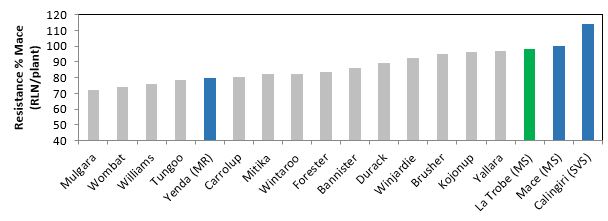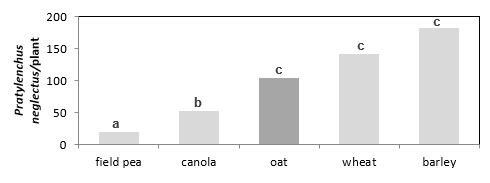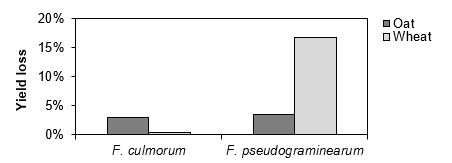Oats, pastures and other legumes – Are rotations offering breaks for root lesion nematodes or crown rot?
Oats, pastures and other legumes – Are rotations offering breaks for root lesion nematodes or crown rot?
Author: Sarah Collins, Carla Wilkinson, and Daniel Hüberli, DPIRD, South Perth. | Date: 26 Feb 2018
Key messages
- Some pasture crops are effective for reducing root lesion nematode (RLN; P. neglectus and P. quasitereoides) populations in a season, but others can greatly increase RLN populations.
- Oats are not a good break crop for reducing P. neglectus or crown rot levels in a paddock. However, for P. neglectus, oats are less susceptible than wheat and variety choice makes a difference. For crown rot, oats can increase inoculum levels similar to wheat.
- Fusarium pseudograminearum caused average yield losses of 4% in oat varieties tested, which is four times lower than check wheat varieties Mace and Emu Rock which had an average yield loss of 17%.
Background and aims
Root lesion nematodes (RLN; Pratylenchus) and crown rot (Fusarium pseudograminearum and F. culmorum)can cause large yield losses in broadacre crops in Western Australia (WA). They are soilborne and compromise a plant's ability to access water and nutrients; by feeding on roots (RLNs) or clogging the root vascular tissues (crown rot). Both are widespread throughout the grain-belt and it has been established that wheat and barley are susceptible (meaning that populations of RLN and crown rot are increased) and cause yield losses. This is also the case for canola for the main species of RLNs in WA.
Luckily this pest and disease can be effectively managed by rotation strategies that reduce or maintain populations at levels that do not impact crop yields. We have been working to increase the range of proven strategies that are viable for growers across the range of environments in the WA grain-belt.
The aims of this research are to provide useful information for:
- Crown rot or RLN (P. neglectus) resistance; ability of the pathogen and pest to increase their populations in current oat varieties.
- Oat variety tolerance to crown rot; the plant’s ability to grow and yield well when the pathogen is present at high levels in the soil.
- Identify pasture alternatives to reduce RLN populations (P. neglectus or P. quasitereoides).
This research enables growers to make better informed decisions on the likely impact oats or pastures have to reduce these soilborne disease and pest issues in their paddocks and the effect they may have on future crop rotations. Although cereals are susceptible to both crown rot and RLNs, resistance can vary between varieties. Hence this research may also enable growers to choose crops or oat varieties that are suited to maximise yield potentials in current and future seasons in infested paddocks. RLN survey and glasshouse experimentation builds on information developed in earlier glasshouse trials at DPIRD, adding weight to preliminary resistance ratings and building confidence in the usefulness of some pasture options.
Method
Root lesion nematodes
The resistance of oat crops to P. neglectus and initial variety data has been developed via two glasshouse trials over two years. Information of the resistance of selected pasture species to RLN was developed by glasshouse experimentation for P. neglectus (2007, 2008 and 2017) and through a field survey for P. quasitereoides (2013-17). In the glasshouse, test plant species were grown for 10 weeks after being inoculated with P. neglectus. The roots of each plant were then washed free of soil and nematodes manually counted after being extracted from the roots over a 4 day period using DPIRD’s mister system. All experiments were adequately replicated to account for the high levels of variation inherent in nematode multiplication.
Crown rot
The resistance/tolerance of oats to crown rot was determined through two seasons of field experimentation in two inoculated trials/ year (total of four trials) on six oat varieties (including Bannister, Carrolup, Durack, Kojonup, Mitika, Williams and Yallara) with two wheat check varieties (Mace and Emu Rock). Additionally, variety trials from 2016 were soil sampled for DNA testing of Fusarium pseudograminearum and F. culmorum levels using PREDICTA® B to determine the inoculum production of oat varieties and then over-sown with wheat in 2017 to determine the impact of inoculum levels on yield (data not yet available).
Results and discussion
Root lesion nematodes
Pastures
A range of pasture crops and some specific pasture varieties show good levels of resistance to WA’s common RLNs; P. quasitereoides and P. neglectus (Table 1 and 2). This means for cropping rotations using susceptible crops like wheat, barley or canola, these pastures will limit RLN multiplication and reduce the chance of damage to a subsequent susceptible crop. Serradella varieties have proven to be resistant in the glasshouse to P. neglectus and in grower paddocks for P. quasitereoides (Table 1 and 2).
In fact, P. quasitereoides population reduction under serradella was better than lupin in the same paddock in Gibson (Table 2, Lupin data not shown). Casbah biserrulla and Dalkeith subterranean clover showed good levels of resistance to P. neglectus in glasshouse experiments conducted in 2017 and 2008 but were susceptible in a 2007 experiment (Table 1). This indicates that in cropping rotations, Casbah biserrulla and Dalkeith subterranean clover are likely to decrease P. neglectus populations in a season, but they may also increase numbers in some circumstances.
Conversely, a number of clover species significantly increased P. neglectus populations in all three glasshouse experiments. Species from popular pasture types, Balansa, Persian and Gland clovers for example, were as bad as the susceptible wheat control in terms of increasing P. neglectus populations in their root systems (Table 1). Therefore these clovers are likely to contribute to increased P. neglectus populations in cropping paddocks and should be avoided in rotation for infested paddocks.
Table 1. Pratylenchus neglectus resistance profiles for pasture species from DPIRD glasshouse experiments in 2017, 2008 and 2007
Crop type | Variety | 2017 | 2008* | 2007** |
|---|---|---|---|---|
Serradella | Cadiz | R | MR | MR |
Serradella | Margurita | R | R | R |
Serradella | Santorini | R | MR | MR |
Biserrulla | Casbah | R | MR | S |
Lupin | Lupin (R Control) | MR | R | R |
Subterranean clover | Dalkeith | MR | MR | S |
Eastern star clover | Sothis | MR | S | S |
Arrow-leaf clover | Cefalu | S | S | S |
Balansa clover | Frontier | - | S | S |
Persian clover | Nitro Plus | SVS | S | S |
Gland clover | Prima | SVS | - | SVS |
Wheat | Wheat (S Control) | SVS | S | S |
R = resistant, MR = moderately resistant, MS = moderately susceptible, S = susceptible, SVS = susceptible to very susceptible.
* Vanstone et al. 2008. **Vanstone et al. 2009.
Table 2. Pratylenchus quasitereoides levels and multiplication in paddocks before and after a French serradella crop.
Location | Season | Paddock | Before Serradella | After Serradella | Multiplication |
|---|---|---|---|---|---|
Pingelly | 2015 | 1 | 21 | 4 | 0.16 |
2015-16 | 2 | 45* | 1 | 0.03 | |
Gibson | 2013 | 1 | 4 | 1 | 0.19 |
* Sample collected at the end of the previous season directly after oats crop
Oats
All oat varieties tested were more resistant to P. neglectus than Mace, which is moderately susceptible (MS) and the most commonly grown wheat variety in WA (Figure 1). Field pea and canola showed better resistance to P. neglectus than oats (Figure 2). In turn, oats trended towards being more resistant than wheat and barley which are both susceptible crops, but this difference was not statistically significant (p>0.05; Figure 2).
While oats are a susceptible crop and are likely to increase P. neglectus when grown in infested paddocks, there was a range in the resistance of oat varieties with some varieties performing well relative to other cereal varieties (Figure 1). For example, Mulgara, Wombat, Williams and Tungoo were comparable to Yenda (MR), which is the most resistant wheat variety (Figure 1). So whilst oat varieties are likely to increase nematode levels in a paddock within a growing season, they appear to be a more effective cereal option within rotations to manage P. neglectus levels.
To verify our findings we are testing a selection of eight oat varieties for resistance to both P. neglectus and P. quasitereoides under field conditions.
Figure 1. Resistance of oat varieties to Pratylenchus neglectus expressed as a percentage of RLN/plant detected in Mace , the most commonly grown wheat variety in Western Australia.
Grey bars represent oats, blue are wheat and green barley varieties. Data is a mean for two glasshouse trials. P. neglectus resistance ratings given for wheat and barley; SVS=susceptible to very susceptible, MS=moderately susceptible, MRMS=moderately resistant to moderately susceptible, MR=moderately susceptible.
Figure 2. Relative resistance of oats to Pratylenchus neglectus in a glasshouse trial. Letters denote significant difference in nematode levels between crops (p<0.05) using Fishers LSD test on ln(x+1) transformed data.
Crown rot
Oats
All oat varieties tested were more tolerant to F. pseudograminearum, which is the predominant crown rot pathogen occurring across the WA grain-belt, than the check wheat varieties, Mace (S) and Emu Rock (MS). In fact, average yield losses for oats were about four times lower than those measured in wheat (Figure 3). Furthermore, for F. culmorum, which occurs primarily in the southern regions, oat and wheat had lower levels of yield loss.
There were no oat varietal differences in yield responses to crown rot. This is good news for growers because it means there is a more tolerant cereal crop option that can be used in rotations where crown rot is a problem. So in paddocks where crown rot risk is high, and a cereal must be sown, then oats appear to be a better choice over wheat in terms of limiting the extent of yield loss.
Inoculum levels of F. pseudograminearum at pre-sowing in 2017 on the previous year's oat variety trials were found to be similar in all oat varieties and the check wheats at both locations (Figure 4). For F. culmorum inoculum, levels were higher in oats than wheat. This means that oats cannot be used as a break crop to reduce crown rot inoculum.
If the management strategy is to reduce crown rot levels in a paddock then a non-cereal crop (canola or lupin) will need to be used with good grass weed control as all grasses and cereals host the crown rot fungus. Broadleaf pasture such as serradella may also be good break crops, however, this has yet to be confirmed in field trials.
Figure 3. Yield loss to Fusarium culmorum and F. pseudograminearum in four inoculated field trials for oats and wheat.
Figure 4. Level of Fusarium culmorum and F. pseudograminearum inoculum in the soil prior to sowing in 2017 for two oat variety trials conducted in 2016.
Conclusion
For the Western Region, proven resistance of serradella pastures to our common RLNs, P. quasitereoides and P. neglectus, offers growers with infested paddocks new management options. Serradella can be used as a cleaning phase for RLN as well as introducing nitrogen naturally to the soil (Loi et al. 2005). This conclusion is drawn from three replicated glasshouse experiments (P. neglectus) and paddock testing (P. quasitereoides) in two port zones.
Biserrulla and subterranean clover also show potential to reduce RLN but more experimentation is necessary to clarify resistance for P. neglectus and P. quasitereoides as well as testing a larger range of varieties for more resistant options. Clovers on the other hand vary greatly in resistance to P. neglectus from very susceptible to moderately resistant so clover type and variety choice needs to be handled with care until more conclusive recommendations can be drawn.
For cereals, some oat varieties add viable rotation options that reduce RLN in infested paddocks. Glasshouse trials have shown that there is a range of resistance levels to P. neglectus in commonly grown oat varieties. All oat varieties had better resistance than the most commonly grown wheat variety, Mace which is moderately susceptible to this RLN. However, overall oats are not resistant to P. neglectus and will likely cause nematode levels to increase in a paddock. This increase in P. neglectus levels may lead to yield loss in subsequent crops. The most resistant oat varieties tested appear to be Mulgara, Wombat, Williams and Tungoo. Resistance ratings are being confirmed in field trials.
For crown rot, oats were found to be about four times more tolerant than Mace (susceptible) and Emu Rock (moderately susceptible), and no varietal differences in yield loss were found amongst the oat varieties tested. This means that if a cereal is to be sown into a paddock with high levels of crown rot, then oats could be a better choice over wheat. However, oats are not break crops and will increase crown rot inoculum levels similarly to wheat. If the crown rot inoculum levels are high, then the best rotation option remains to grow non-cereal break crops such as canola or pulses.
References
Loi A, Howieson JG, Nutt BJ, Carr SJ (2005). A second generation of annual pasture legumes and their potential for inclusion in Mediterranean-type farming systems. Australian Journal of Experimental Agriculture 45: 289-299.
Vanstone V, Bhatti A, You M (2008). The role of pastures in hosting root lesion nematode (RLN, Pratylenchus neglectus). GRDC Agribusiness Crop Updates. Perth, Western Australia, Department of Agriculture and Food, Western Australia.
Vanstone V, Hunter H, Kelly S (2009). Screening cereal, canola and pasture cultivars for root lesion nematode (Pratylenchus neglectus). GRDC Agribusiness Crop Updates. Perth, Western Australia. p. 119-122.
Acknowledgments
Angelo Loi, Ron Yates (DPIRD pasture management) and Georgie Troup (DPIRD oats breeding), Pamela Zwer (SARDI) provided seed and advice for growing pastures and oats. DPIRD plant pathology assisted in glasshouse and field trials and data analysis: staff Sean Kelly, Miriam Connor, Helen Hunter, Kris Gajda and Lucy DeBrincat.
Data analysis of the crown rot oats trials was conducted by DPIRD biometrician, Andrew Van Burgel. DPIRD region research units managed all field experiments: Merredin RS, Shari Dougall, Tracey Mouritzen and Rob de Gruchy.
The research undertaken is made possible by the significant contributions of growers through both trial cooperation and COGGO, DPIRD Boosting Grains and GRDC investment. We would like to thank them for their continued support.
COGGO: Resistance of milling and hay oats to root lesion nematodes Pratylenchus neglectus and P. quasitereoides in Western Australia
DPIRD through the Boosting Grains R&D Project: Tolerance and resistance of oats to crown rot in WA (FFPjP03) which aligns with the GRDC national crown rot program (DAN00175)
GRDC: National nematode epidemiology and management program (DAV00128)
Paper reviewed by: Steven Simpfendorfer (NSW DPI)
GRDC Project Code: DAV00128,




